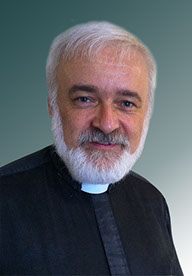By Peter Armstrong
Many years ago, in a field outside Bethlehem of Judea, some shepherds were terrified when they were confronted by an angel of the Lord. “But the angel said to them, ‘Do not be afraid; for see—I am bringing you good news of great joy for all the people: to you is born this day in the city of David a Saviour, who is the Messiah, the Lord.’”[1]
This startling announcement proclaimed the incarnation of the Son of God into this broken world. It is “good news of great joy for all the people.” The incarnation of Jesus Christ, and his ministry, death, and resurrection which followed, are the foundation of the Christian gospel. Inspired by God the Holy Spirit, Christians everywhere have sought to proclaim and to live the good news of the kingdom, which is rooted in the person and work of Jesus Christ. As Anglicans, we recognize that we have the responsibility and the privilege to share the gospel, so as to make disciples everywhere.
In 2023, the General Synod of the Anglican Church of Canada identified five “transformational aspirations”:
Our Anglican Church of Canada aspires to:
- Invite and deepen life in Christ
- Champion the dignity of every human being; work to dismantle racism and colonialism
- Embrace mutual interdependence with the Indigenous church (Sacred Circle)
- Nurture right relationship among people of faith in local, national and global communities and networks
- Steward and renew God’s creation: protect and sustain the earth; pursue justice for all.[2]
These Transformational Aspirations were adopted at that General Synod. “Aspirations” suggest worthwhile goals to aim for, but which are still incomplete among us. Notably, these aspirations reflect the concerns of Canadian Anglicans—such as care for the natural environment, and relationships among Indigenous and non-Indigenous Anglicans. The shadow of past indignities by “settler” Anglicans is seen both in the reference to the baptismal vows in the B.A.S. (“the dignity of every human being”[3]), and “work to dismantle racism and colonialism.” Most important of all, the first “aspiration” is to “invite and deepen life in Christ.” Presented in graphic form, the first aspiration is presented as central, with the other aspirations connected to it like a pinwheel.[4] It can be said that all the other priorities for the Anglican Church of Canada flow from this first aspiration.
In an amendment put forward and adopted at General Synod 2023, “aspirations” became “commitments,” affirming more concretely our desire to adopt and to live out these principles.[5]
It takes time for goals to be developed within a large and diverse institutional structure. Under the direction of the former Primate, Archbishop Linda Nicholls, a task force was struck—a “Primate’s Commission.” In her letter mandating this Commission, Archbishop Nicholls wrote: “Over the past several years questions have emerged about the shape of the life of the Church that will best serve vibrant, healthy parishes and our commitment to being the body of Christ across provinces, nationally and internationally in the Anglican Communion. These questions need to be considered with care and theological reflection, so that the structures of our Church life will best serve the gospel.”[6]
Note that the former Primate suggests how these broad questions need to be engaged: “—with care and theological reflection, so that the structures of our Church life will best serve the gospel.” “How can the Church best serve the gospel” is the central question for the people of God.
In mid-2024, the Primate’s Commission produced “Seven Hypotheses.[7]” These hypotheses call for a substantial re-ordering of the Church’s life. Particularly, they address the Anglican Church of Canada’s administrative, communication, and bureaucratic structure. After the Commission received feedback, the “Seven Hypotheses” became “Six Pathways.” These “Pathways” have been considered by the Council of General Synod, and will be presented for consideration at the upcoming General Synod, in June 2025.
The six Pathways are:
- Organizational structure
- Management overview and restructuring
- Inclusion and diversity in decision making
- Communications
- Walking in partnership with the Indigenous church
- Ministry in remote northern communities.[8]
The authors of the document observe, “[Our] top-heavy structure focuses human and financial resources on maintaining outsized institutions rather than proclaiming the gospel in local communities.”[9] The aim of the Church is “proclaiming the gospel in local communities”—this is the authors’ presupposition.
Regretfully, however, that is the last explicit reference to the Church’s work of the gospel, in a significant document calling for a substantial re-ordering within our common life.
Implicit—but notably, never named—within this set of proposals is a significant cost-cutting effort. As parish and diocesan revenues decline, so too do resources for the National Church. While the National Church has some capacity to control revenue through investments, it primarily depends on healthy, generous parishes to contribute apportionment revenue to the wider Church. These proposed Pathways emerge at a moment when many Canadian Anglican parishes are financially unhealthy.[10]
It is entirely appropriate that we address the structures of our common institutional life. What is deeply concerning, however, is not what is written, but what has been left out. Our common commitment to the gospel of Jesus Christ is central to our identity, and for the Church’s recovery. It needs to be articulated, adopted firmly without reservation, and lived out in our common life.
The effective implementation of some or all of these Pathways by themselves will neither arrest nor reverse institutional decline. Reducing costs simply extends the institution’s life. Instead, let us consider how to revitalize the institution. One necessary step is to increase income. Money is one of the tools which makes ministry happen. Among other priorities, we need to generate revenue as one instrument to re-energize God’s Church. That is, the Church’s financial stewardship expects spiritually mature Anglicans who receive income to contribute financially toward the Church’s ministry. The only effective plan in the Church’s history is effective evangelization and discipleship.[11]
The Anglican Church of Canada as we know it might fail, even with sincere efforts to evangelize and to disciple this generation. However, the Anglican Church of Canada (the national institution as we know it, not the Body of Christ) shall fail without these priorities being implemented.
Some readers, including proponents of the Pathways themselves, may protest: “Of course, we need evangelization and discipleship; we just didn’t state it. The aim of the Pathways is to stir the Church into a substantial discussion, toward very significant institutional reform.” However, assuming the priorities of evangelization and discipleship, without integrating these priorities explicitly and concretely into our policy decisions, regrettably points in the direction of failure. We need to re-capture and embrace the principles of the gospel in our common life, from the smallest congregation to throughout our national structures.
Explicit in the Church’s own life is the conviction that our beliefs need to be named and shared in our common life—in our preaching and teaching (I Corinthians 1: 23); in our sacramental life (I Corinthians 11: 23); evangelization (Acts 3: 20); and ongoing discipleship (Ephesians 4:1-2).
For those unpersuaded by Bible verses, this is also demonstrated through empirical data. Numerous studies demonstrate the benefit of explicitly naming the institution’s values, and concrete planning, more likely leading to “success.”[12]
Research into Church growth has consistently shown that articulating the work of the gospel (and how it is lived out in local congregations) makes it more likely for congregations to achieve these aims.[13]
It is appropriate to examine new ways of being “Church.” We need to be bold. We also need to face squarely the fact that, with some notable exceptions, our common life has failed to engage well with our current Canadian culture.
This collection of essays and reflections aims to engage what our institutional life needs to look like. Canadian Anglicans need to ask ourselves: What presuppositions about the nature of the Church need to be embedded within us? What kind of leadership structure is faithful in our current climate?
In cooperation with God, our aim needs to be Revival—understood in the classical sense.[14] That is, we want the Church to have a rich, Spirit-filled commitment to sharing the gospel in our generation, so that lives can be transformed, and God’s priorities reign in our midst. Integral to this process is the proclamation and living of the Christian gospel, boldly, humbly, and faithfully. Significant institutional reform is not only administrative, nor is it merely aiming to influence good public policy—although both of these are laudable goals. The Lord Jesus began with twelve friends, to whom he taught and modelled a transformed relationship with God. Individual lives changed by the Spirit of the Lord, being shaped within the community of the faithful, build up the Church.[15]
There is already good evidence about what qualities make up a healthy Church. The priorities which make healthy parishes also make for a well-resourced National Church. These priorities include:
- clear, gracious Christian commitment
- high tolerance for a degree of messiness in our common life
- broad biblical and theological literacy, with sensitive application
- an absolute commitment to outreach & mission (even in difficult financial circumstances)
- healthy internal relationships
- gracious mature leadership
- the capacity to be nimble[16]
The ministry of the Church is not primarily a human enterprise. We begin with the conviction of the presence and work of the Living God of the universe participating in human affairs, for our own good. God gives us the grace to accomplish his priorities, when we seek to be faithful (Romans 5: 1-5).
We hope that at the upcoming General Synod, the Six Pathways, and what informs these proposals, will be considered thoughtfully and adopted effectively. Far more importantly, we hope that the Church will live in full response to the angelic message to the shepherds, and all that follows. We want Canadian Anglicans to be passionate and determined to work in cooperation with God for the growth of God’s Church (for it never has been “our” Church), and for the further establishment of Christ’s kingdom.
Amen.
————————————-
[1] St. Luke 2: 10-11, N.R.S.V. translation.
[2] https://changingchurch.anglican.ca/genesis/ [downloaded 13 May 2025].
[3] Book of Alternative Services, p. 158.
[4] https://changingchurch.anglican.ca/genesis/ [downloaded 14 May 2025].
[5] https://anglicanjournal.com/synod-votes-no-to-extending-primates-term/ [downloaded 13 May 2025].
[6] https://www.anglican.ca/wp-content/uploads/Introducing-Commission.pdf [downloaded 13 May 2025].
[7] https://livingchurch.org/news/news-anglican-communion/seven-hypotheses-stir-debate-in-canadian-church/ [downloaded 13 May 2025].
[8] https://episcopalnewsservice.org/2025/03/10/canadian-primates-commission-recommends-cuts-to-top-heavy-church-structures/ [downloaded 13 May 2025]; https://anglicanjournal.com/panel-outlines-six-paths-to-big-change-in-church/ [downloaded 13 May 2025].
[9] https://anglicanjournal.com/primates-commission-recommends-cuts-to-top-heavy-church-structures/ [downloaded 13 May 2025].
[10] https://broadview.org/anglican-church-of-canada-mulls-changes/ [downloaded 13 May 2025].
[11] https://agtimes.ag.org.sg/the-link-between-discipleship-and-evangelism/ [downloaded 13 May 2025]; https://www.transformationbymovement.com/church-transformation/what-are-the-4-pillars-of-church-growth/ [downloaded 13 May 2025].
[12] https://marketing.wharton.upenn.edu/wp-content/uploads/2022/02/200-JSA-The-Value-of-Formal-Planning-for-Strategic-Decisions-Review-of-Empirical-Research.pdf [downloaded 13 May 2025]; https://www.achievers.com/blog/organizational-culture-definition/ [downloaded 13 May 2025].
[13] https://blog.horizons.net/the-importance-of-goal-setting-in-ministry-aligning-mission-vision [downloaded 13 May 2025]; https://www.willmancini.com/blog/taking-vision-public-step-1-articulating-your-churchs-vision [downloaded 13 May 2025]; http://www.churchleadership.org/apps/articles/default.asp?articleid=41872&columnid=4541 [downloaded 13 May 2025].
[14] Some of us may have misconceptions about what “revival” looks like. It is sometimes thought to be short-lived fanaticism, rather than rich, deep transformation within the Body of Christ.
[15] Consider, for example, Luke 8: 1ff, Luke 9: 1ff, Luke 10: 1ff. There is a progression, from Christ alone preaching and doing kingdom work, then equipping the 12 apostles, then the 70 or so others to continue this work.
[16] Christian A. Schwarz & Christoph Schalk, Implementation Guide to Natural Church Development, Church Smart Resources: U.S.A., 1998. “Affirming the Truth of the Gospel: Anglicans in Pluralist Canada,” Donald Posterski, Anglican Essentials, George Egerton, editor, Anglican Book Centre: Canada, 1995, p. 34ff. Mark Miller, The Heart of Leadership, Berrett-Koehler Publications Inc.: U.S.A., 2013. https://www.transformationbymovement.com/church-transformation/what-are-the-4-pillars-of-church-growth/ [downloaded 13 May 2025]. https://freechurch.org/healthy-church-characteristics/ [downloaded 13 May 2025].

The Rev. Dr. Peter Armstrong is Rector of St. Brice’s Anglican Church in North Bay, ON, and serves as Secretary for Anglican Communion Partners (Canada).

